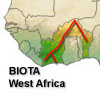Project description |
Agricultural productivity is especially low in the Sahelian and Sudano-Sahelian zones of West Africa. Re-actualisation of traditional knowledge may serve as an efficient approach to fertility management, especially if the methods are scientifically analysed, improved, and optimally adapted to the respective ecological and the changed socio-economic conditions and demands.
As “ecosystem engineers” , termites and ants modify and create habitats, and contribute decisively to vital ecosystem processes. A few local subsistence farmers readopted an ancestral practice for regenerating very poor fields in semi-arid areas, making use of the positive effects termites exert on soil properties, called the Zaï system. Two successive forms of Zaï exist: In the agricultural form, the farmers dig holes (microwatersheds) and put seeds together with organic material into the cavities. Therewith termites are attracted and decompose this material, thus improving soil fertility. Their burrowing activity increases the soil’s porosity, enhancing its aeration and water infiltration capacity. After 4 - 5 years of uninterrupted agricultural Zaï cultivation fields lie fallow to start the forestry Zaï. Within few years rich woody and herbaceous vegetation develops by itself.
The workpackage therefore focuses on collecting baseline data:
- to determine the effects of termites on soil physico-chemical properties and on ecosystem processes (water and nutrient dynamics) along the successive stages of soil restoration.
- to characterize the diversity and activity (i.e. the biogenic structures) of termites and ants within the main successive stages of the Zaï system.
and furthermore reveals necessary information on
- direct and indirect effects of termites on water and nutrient dynamics.
- manipulation of termites to improve the traditional soil restoration system Zaї.
|






 Go to the WeatherNet
Go to the WeatherNet BIOTA West Africa - Workpackage - CT2-T3-WP2
BIOTA West Africa - Workpackage - CT2-T3-WP2 Ecosystem services of termites in West Africa: soil restoration and carbon mitigation in the traditional Zaï system
Ecosystem services of termites in West Africa: soil restoration and carbon mitigation in the traditional Zaï system